Evaluation of Sub-Kilometric Numerical Simulations of C-Band Radar Backscatter over the French Alps against Sentinel-1 Observations
Abstract
1. Introduction
2. Data and Models
2.1. Sentinel-1 Data
2.2. SAFRAN-Crocus
2.3. MEMLS3&a
2.4. Model Configuration and Simulation Setups
2.5. Evaluation
3. Results
3.1. Snow-Free Situations
3.2. Comparisons over the Full Domain
3.3. Comparisons at High Elevation Locations
3.4. Influence of Crocus Liquid Water Percolation Parameterizations
4. Discussion and Conclusions
Author Contributions
Funding
Acknowledgments
Conflicts of Interest
References
- Nolin, A.W. Recent advances in remote sensing of seasonal snow. J. Glaciol. 2010, 56, 1141–1150. [Google Scholar] [CrossRef]
- Singh, M.K.; Gupta, R.; Bhardwaj, A.; Joshi, P.K. Remote sensing of mountain snow using active microwave sensors: A review. Geocarto Int. 2015, 30, 1–27. [Google Scholar] [CrossRef]
- Bormann, K.; Brown, R.D.; Derksen, C.; Painter, T. Estimating snow-cover trends from space. Nat. Clim. Change 2018, 8. [Google Scholar] [CrossRef]
- Phan, X.V.; Ferro-Famil, L.; Gay, M.; Durand, Y.; Dumont, M.; Morin, S.; Allain, S.; D’Urso, G.; Girard, A. 1D-Var multilayer assimilation of X-band SAR data into a detailed snowpack model. Cryosphere 2014, 8, 1975–1987. [Google Scholar] [CrossRef]
- Nagler, T.; Rott, H.; Ripper, E.; Bippus, G.; Hetzenecker, M. Advancements for Snowmelt Monitoring by Means of Sentinel-1 SAR. Remote Sens. 2016, 8, 348. [Google Scholar] [CrossRef]
- Shi, J.; Dozier, J. Radar backscattering response to wet snow. In Proceedings of the IGARSS’92 Geoscience and Remote Sensing Symposium, Houston, TX, USA, 26–29 May 1992; IEEE: Piscataway, NJ, USA, 1992; Volume 2, pp. 927–929. [Google Scholar]
- Rott, H.; Davis, R.E. Multifrequency and polarimetric SAR observations on alpine glaciers. Ann. Glaciol. 1993, 17, 98–104. [Google Scholar] [CrossRef]
- Baghdadi, N.; Gauthier, Y.; Bernier, M. Capability of multitemporal ERS-1 SAR data for wet-snow mapping. Remote Sens. Environ. 1997, 60, 174–186. [Google Scholar] [CrossRef]
- Koskinen, J.; Metsämäki, S.; Grandell, J.; Jänne, S.; Matikainen, L.; Hallikainen, M. Snow Monitoring Using Radar and Optical Satellite Data. Remote Sens. Environ. 1999, 69, 16–29. [Google Scholar] [CrossRef]
- Shi, J.; Dozier, J. Mapping seasonal snow with SIR-C/X-SAR in mountainous areas. Remote Sens. Environ. 1997, 59, 294–307. [Google Scholar] [CrossRef]
- Magagi, R.; Bernier, M. Optimal conditions for wet snow detection using RADARSAT SAR data. Remote Sens. Environ. 2003, 84, 221–233. [Google Scholar] [CrossRef]
- Baghdadi, N.; Gauthier, Y.; Bernier, M.; Fortin, J.P. Potential and Limitations of RADARSAT SAR Data for Wet Snow Monitoring. IEEE Trans. Geosci. Remote 2000, 38, 316–320. [Google Scholar] [CrossRef]
- Rott, H.; Mätzler, C. Possibilities and Limits of Synthetic Aperture Radar for Snow and Glacier Surveying. Ann. Glaciol. 1987, 9, 195–199. [Google Scholar] [CrossRef]
- Shi, J.; Dozier, J. Inferring Snow Wetness Using C-Band Data from SIR-C’s Polarimetric Synthetic Aperture Radar. IEEE Trans. Geosci. Remote 1995, 33, 905–914. [Google Scholar]
- Besic, N.; Vasile, G.; Chanussot, J.; Stankovic, S.; Dedieu, J.P.; d’Urso, G.; Boldo, D.; Ovarlez, J.P. Dry Snow Backscattering Sensitivity on Density change for SWE Estimation. In Proceedings of the IEEE International Geoscience and Remote Sensing Symposium (IGARSS 2012), Munich, Germany, 22–27 July 2012. [Google Scholar]
- Besic, N.; Vasile, G.; Chanussot, J.; Stankovic, S.; Boldo, D.; d’Urso, G. Wet Snow Backscattering Sensitivity on Density change for SWE Estimation. In Proceedings of the IEEE International Geoscience and Remote Sensing Symposium (IGARSS 2013), Melbourne, VIC, Australia, 21–26 July 2013. [Google Scholar]
- Longepe, N.; Allain, S.; Ferro-Famil, L.; Pottier, E.; Durand, Y. Snowpack characterization in mountainous regions using C-Band SAR data and a meteorological model. IEEE Trans. Geosci. Remote Sens. 2009, 47, 406–418. [Google Scholar] [CrossRef]
- Cui, Y.; Xiong, C.; Lemmetyinen, J.; Shi, J.; Jiang, L.; Peng, B.; Li, H.; Zhao, T.; Ji, D.; Hu, T. Estimating Snow Water Equivalent with Backscattering at X and Ku Band Based on Absorption Loss. Remote Sens. 2016, 8, 505. [Google Scholar] [CrossRef]
- Pulliainen, J. Mapping of snow water equivalent and snow depth in boreal and sub-arctic zones by assimilating space-borne microwave radiometer data and ground-based observations. Remote Sens. Environ. 2006, 101, 257–269. [Google Scholar] [CrossRef]
- Dumont, M.; Durand, Y.; Arnaud, Y.; Six, D. Variational assimilation of albedo in a snowpack model and reconstruction of the spatial mass-balance distribution of an alpine glacier. J. Glaciol. 2012, 58, 151–164. [Google Scholar] [CrossRef]
- Cluzet, B.; Revuelto, J.; Lafaysse, M.; Dumont, M.; Cosme, E.; Tuzet, F. Assimilation of MODIS observations of snowpack surface properties into one year of spatialized ensemble snowpack simulations at a field site in the French Alps. In Proceedings of the ISSW, Innsbruck, Austria, 7–12 October 2018. [Google Scholar]
- Ulaby, F.; Moore, R.; Fung, A. Microwave Remote Sensing: Active and Passive, Volume 2-Radar Remote Sensing and Surface Scattering and Emission Theory; Artech House: Norwood, MA, USA, 1982. [Google Scholar]
- Wiesmann, A.; Mätzler, C. Microwave Emission Model of Layered Snowpacks. Remote Sens. Environ. 1999, 70, 307–316. [Google Scholar] [CrossRef]
- Proksch, M.; Mätzler, C.; Wiesmann, A.; Lemmetyinen, J.; Schwank, M.; Löwe, H.; Schneebeli, M. MEMLS3&a: Microwave Emission Model of Layered Snowpacks adapted to include backscattering. Geosci. Model Dev. 2015, 8, 2611–2626. [Google Scholar]
- Wiesmann, A.; Fierz, C.; Mätzler, C. Simulation of microwave emission from physically modeled snowpacks. Ann. Glaciol. 2000, 31, 397–405. [Google Scholar] [CrossRef]
- Brucker, L.; Royer, A.; Picard, G.; Langlois, A.; Fily, M. Hourly simulations of the microwave brightness temperature of seasonal snow in Quebec, Canada, using a coupled snow evolution-emission model. Remote Sens. Environ. 2011, 115, 1966–1977. [Google Scholar] [CrossRef]
- Montpetit, B.; Royer, A.; Roy, A.; Langlois, A.; Derksen, C. Snow Microwave Emission Modeling of Ice Lenses Within a Snowpack Using the Microwave Emission Model for Layered Snowpacks. IEEE Trans. Geosci. Remote Sens. 2013, 51, 4705–4717. [Google Scholar] [CrossRef]
- Lemmetyinen, J.; Kontu, A.; Pulliainen, J.; Vehviläinen, J.; Rautiainen, K.; Wiesmann, A.; Mätzler, C.; Werner, C.; Rott, H.; Nagler, T.; et al. Nordic Snow Radar Experiment. Geosci. Instrum. Methods Data Syst. 2016, 5, 403–415. [Google Scholar] [CrossRef]
- King, J.; Derksen, C.; Toose, P.; Langlois, A.; Larsen, C.; Lemmetyinen, J.; March, P.; Montpetit, B.; Roy, A.; Rutter, N.; et al. The influence of snow microstructure on dual-frequency radar measurements in a tundra environment. Remote Sens. Environ. 2018, 215, 242–254. [Google Scholar] [CrossRef]
- Brun, E.; David, P.; Sudul, M.; Brunot, G. A numerical model to simulate snow-cover stratigraphy for operational avalanche forecasting. J. Glaciol. 1992, 38, 13–22. [Google Scholar] [CrossRef]
- Vionnet, V.; Brun, E.; Morin, S.; Boone, A.; Martin, E.; Faroux, S.; Moigne, P.L.; Willemet, J.M. The detailed snowpack scheme Crocus and its implementation in SURFEX v7.2. Geosci. Model. Dev. 2012, 5, 773–791. [Google Scholar] [CrossRef]
- Carmagnola, C.M.; Morin, S.; Lafaysse, M.; Domine, F.; Lesaffre, B.; Lejeune, Y.; Picard, G.; Arnaud, L. Implementation and evaluation of prognostic representations of the optical diameter of snow in the SURFEX/ISBA-Crocus detailed snowpack model. Cryosphere 2014, 8, 417–437. [Google Scholar] [CrossRef]
- Bamler, R. Principles of Synthetic Aperture Radar. Surv. Geophys. 2000, 21. [Google Scholar] [CrossRef]
- Frost, V.S.; Shanmugan, K.S.; Stiles, J.A.; Holtzman, J.C. A Model for Radar Images and Its Application to Adaptive Digital Filtering of Multiplicative Noise. IEEE Trans. Pattern Anal. Mach. Intell. 1982, 4, 157–166. [Google Scholar] [CrossRef]
- Schreier, G. (Ed.) SAR Geocoding: Data and Systems; Wichmann Verlag: Karlsruhe, Germany, 1993. [Google Scholar]
- Decharme, B.; Boone, A.; Delire, C.; Noilhan, J. Local evaluation of the Interaction between Soil Biosphere Atmosphere soil multilayer diffusion scheme using four pedotransfer functions. J. Geophys. Res. 2011, 116, D20126. [Google Scholar] [CrossRef]
- Masson, V.; Le Moigne, P.; Martin, E.; Faroux, S.; Alias, A.; Alkama, R.; Belamari, S.; Barbu, A.; Boone, A.; Bouyssel, F.; et al. The SURFEXv7.2 land and ocean surface platform for coupled or offline simulation of Earth surface variables and fluxes. Geosci. Model Dev. 2013, 6, 929–960. [Google Scholar] [CrossRef]
- Durand, Y.; Giraud, G.; Laternser, M.; Etchevers, P.; Mérindol, L.; Lesaffre, B. Reanalysis of 47 Years of Climate in the French Alps (1958–2005): Climatology and Trends for Snow Cover. J. Appl. Meteorol. Clim. 2009, 48, 2487–2512. [Google Scholar] [CrossRef]
- Durand, Y.; Giraud, G.; Laternser, M.; Etchevers, P.; Mérindol, L.; Lesaffre, B. Reanalysis of 44 Yr of Climate in the French Alps (1958–2002): Methodology, Model Validation, Climatology, and Trends for Air Temperature and Precipitation. J. Appl. Meteorol. Clim. 2009, 48, 429–449. [Google Scholar] [CrossRef]
- Wegmüller, U.; Mätzler, C. Rough Bare Soil Reflectivity Model. IEEE Trans. Geosci. Remote 1999, 37, 1391–1395. [Google Scholar] [CrossRef]
- Mironov, V.L.; Kosolapova, L.G.; Fomin, S.V. Physically and Mineralogically Based Spectroscopic Dielectric Model for Moist Soils. IEEE Trans. Geosci. Remote 2009, 47, 2059–2070. [Google Scholar] [CrossRef]
- Vionnet, V.; Dombrowski-Etchevers, I.; Lafaysse, M.; Quéno, L.; Seity, Y.; Bazile, E. Numerical Weather Forecasts at Kilometer Scale in the French Alps: Evaluation and Application for Snowpack Modeling. J. Hydrometeorol. 2016, 17, 2591–2614. [Google Scholar] [CrossRef]
- Revuelto, J.; Lecourt, G.; Lafaysse, M.; Zin, I.; Charrois, L.; Vionnet, V.; Dumont, M.; Rabatel, A.; Six, D.; Condom, T.; et al. Multi-Criteria Evaluation of Snowpack Simulations in Complex Alpine Terrain Using Satellite and In Situ Observations. Remote Sens. 2018, 10, 1171. [Google Scholar] [CrossRef]
- Revuelto, J.; Vionnet, V.; Lopez-Moreno, J.I.; Lafaysse, M.; Morin, S. Combining snowpack modeling and terrestrial laser scanner observations improves the simulation of small scale snow dynamics. J. Hydrol. 2016, 533, 291–307. [Google Scholar] [CrossRef]
- Lafaysse, M.; Cluzet, B.; Dumont, M.; Lejeune, Y.; Vionnet, V.; Morin, S. A multiphysical ensemble system of numerical snow modelling. Cryosphere Discuss. 2017, 2017, 1–42. [Google Scholar] [CrossRef]
- Pahaut, E. Les cristaux de neige et leur métamorphose. In Monographie No. 96 de la Météorologie Nationale; Ministère des Transports: Paris, France, 1975. [Google Scholar]
- Wever, N.; Fierz, C.; Mitterer, C.; Hirashima, H.; Lehning, M. Solving Richards Equation for snow improves snowpack meltwater runoff estimations in detailed multi-layer snowpack model. Cryosphere 2014, 8, 257–274. [Google Scholar] [CrossRef]
- Boone, A.; Etchevers, P. An Intercomparison of Three Snow Schemes of Varying Complexity Coupled to the Same Land Surface Model: Local-Scale Evaluation at an Alpine Site. J. Hydrometeorol. 2001, 2, 374–394. [Google Scholar] [CrossRef]
- Wever, N.; Vera Valero, C.; Fierz, C. Assessing wet snow avalanche activity using detailed physics based snowpack simulations. Geophys. Res. Lett. 2016, 43, 5732–5740. [Google Scholar] [CrossRef]
- Sun, S.; Che, T.; Wang, J.; Li, H.; Hao, X.; Wang, Z.; Wang, J. Estimation and Analysis of Snow Water Equivalents Based on C-Band SAR Data and Field Measurements. Arct. Antarct. Alpine Res. 2015, 47, 313–326. [Google Scholar] [CrossRef]
- Nagler, T.; Rott, H. Retrieval of wet snow by means of multitemporal SAR data. IEEE Trans. Geosci. Remote Sens. 2000, 38, 754–765. [Google Scholar] [CrossRef]
- D’Amboise, C.J.L.; Müller, K.; Oxarango, L.; Morin, S.; Schuler, T.V. Implementation of a physically based water percolation routine in the Crocus/SURFEX (V7.3) snowpack model. Geosci. Model Dev. 2017, 10, 3547–3566. [Google Scholar]
- Picard, G.; Sandells, M.; Löwe, H. SMRT: An active–passive microwave radiative transfer model for snow with multiple microstructure and scattering formulations (v1.0). Geosci. Model Dev. 2018, 11, 2763–2788. [Google Scholar] [CrossRef]
- Dee, D.P. Bias and data assimilation. Q. J. R. Meteorol. Soc. 2005, 131, 3323–3343. [Google Scholar] [CrossRef]
- Berry, T.; Harlim, J. Correcting Biased Observation Model Error in Data Assimilation. Mon. Weather Rev. 2017, 145, 2833–2853. [Google Scholar] [CrossRef]






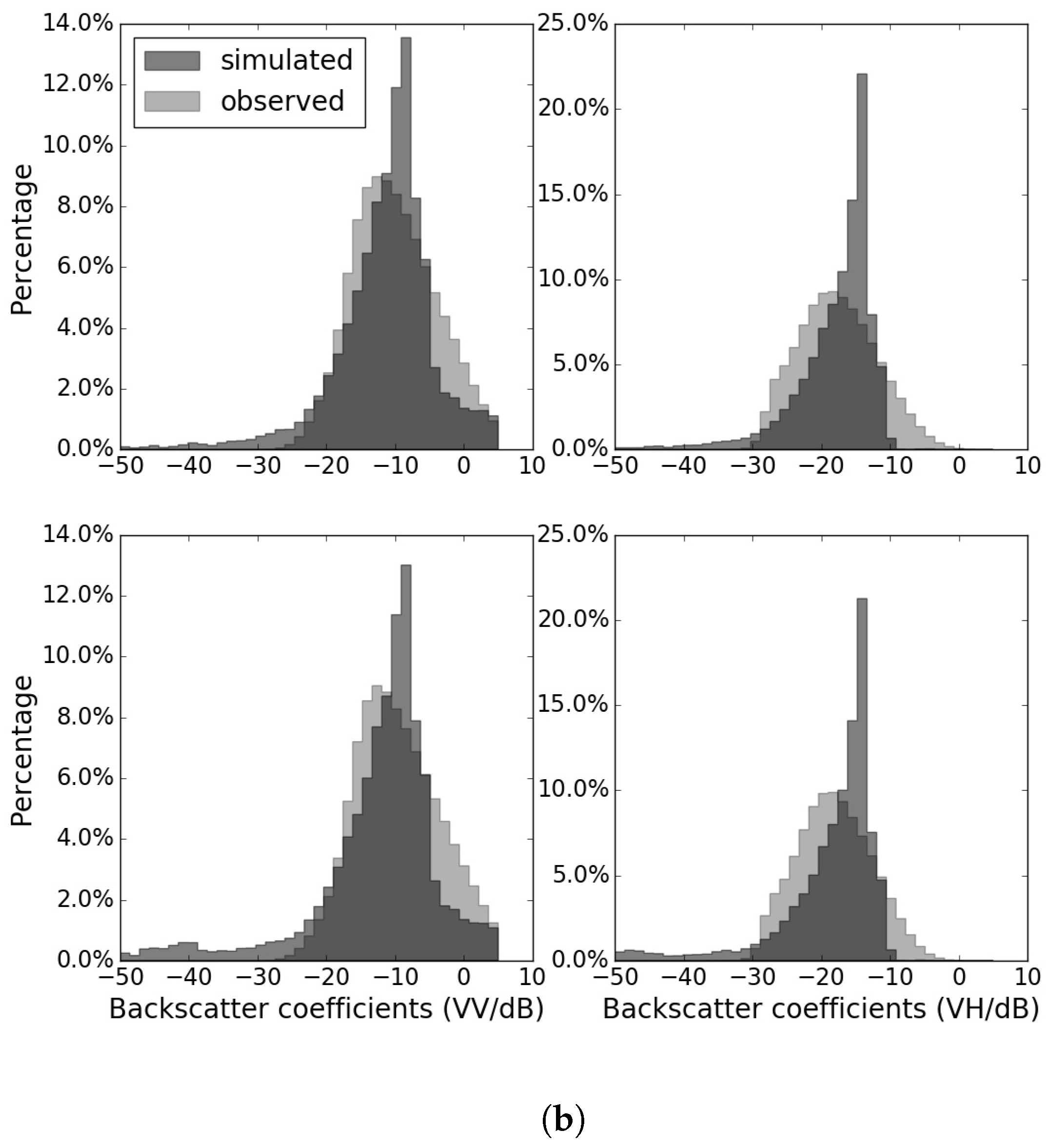
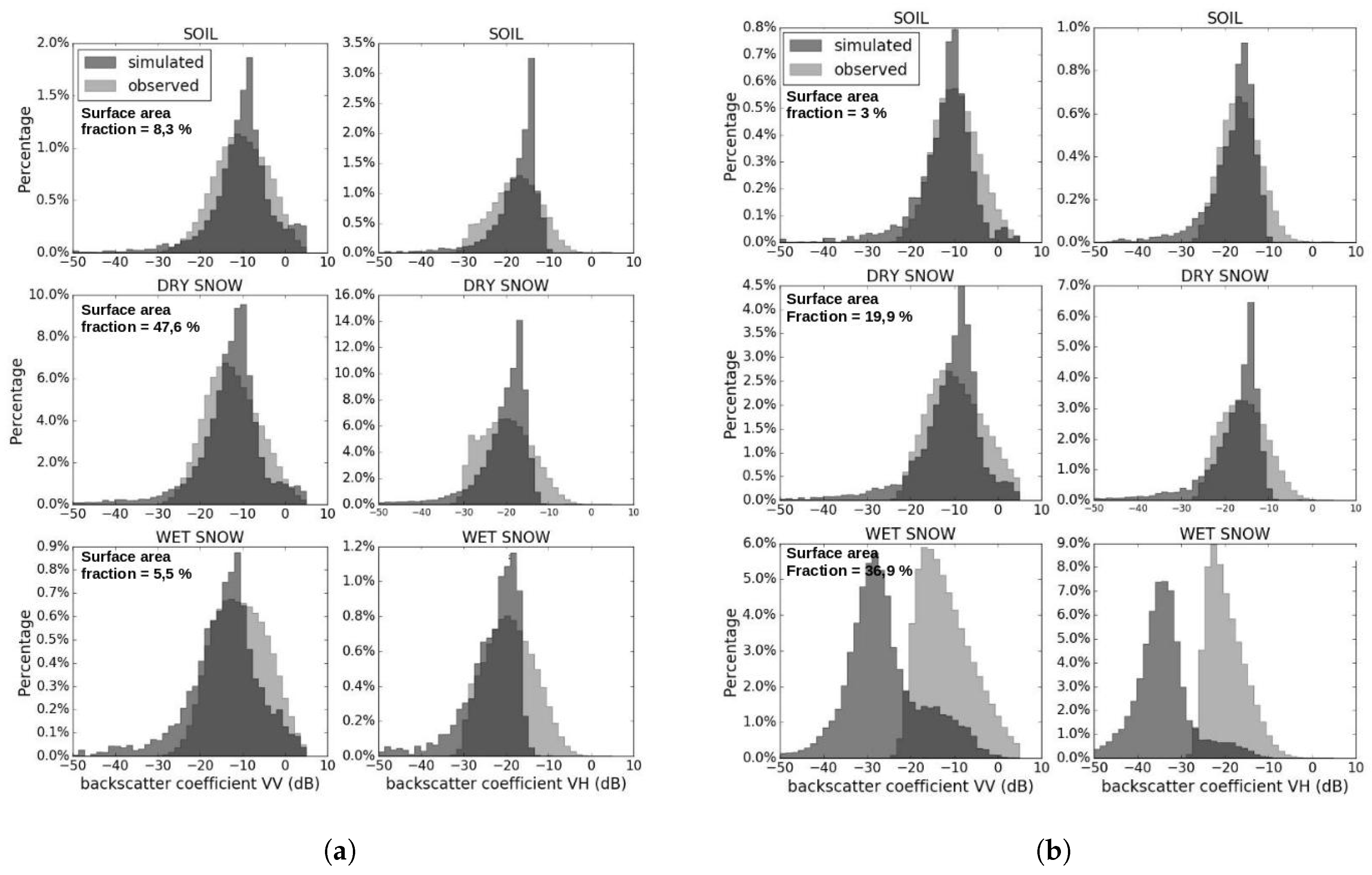
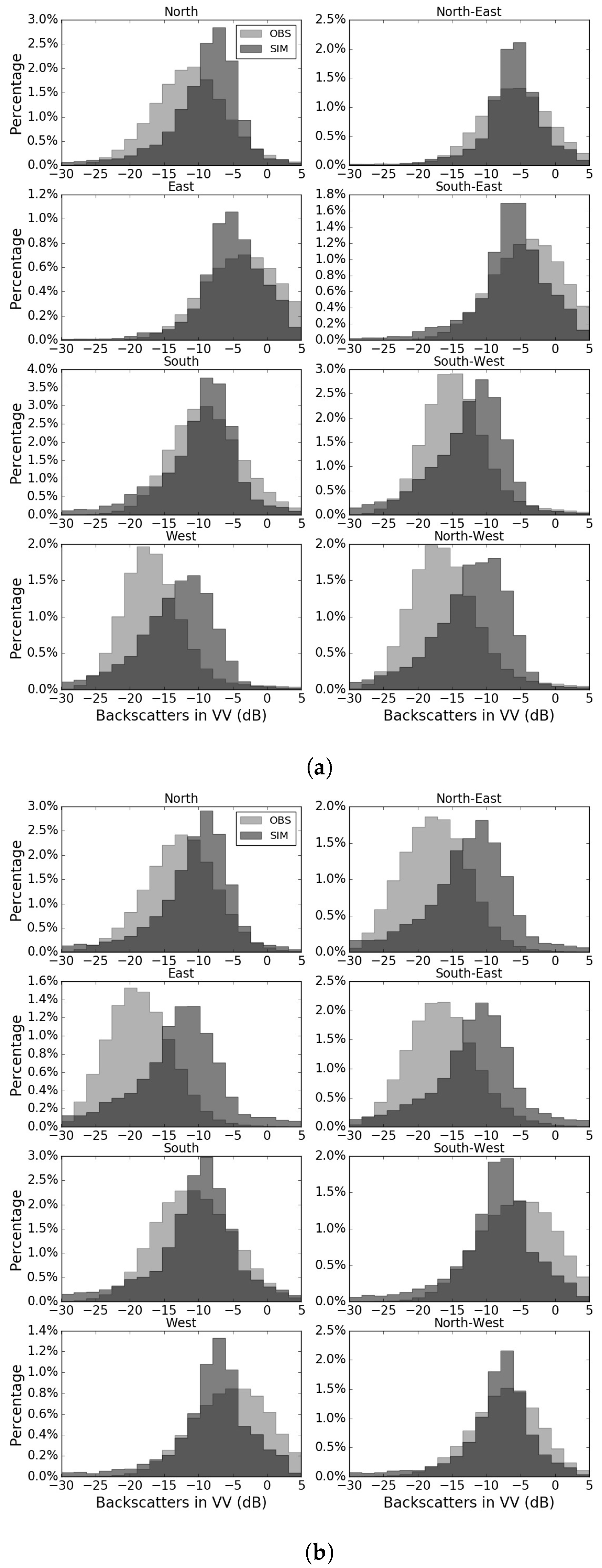
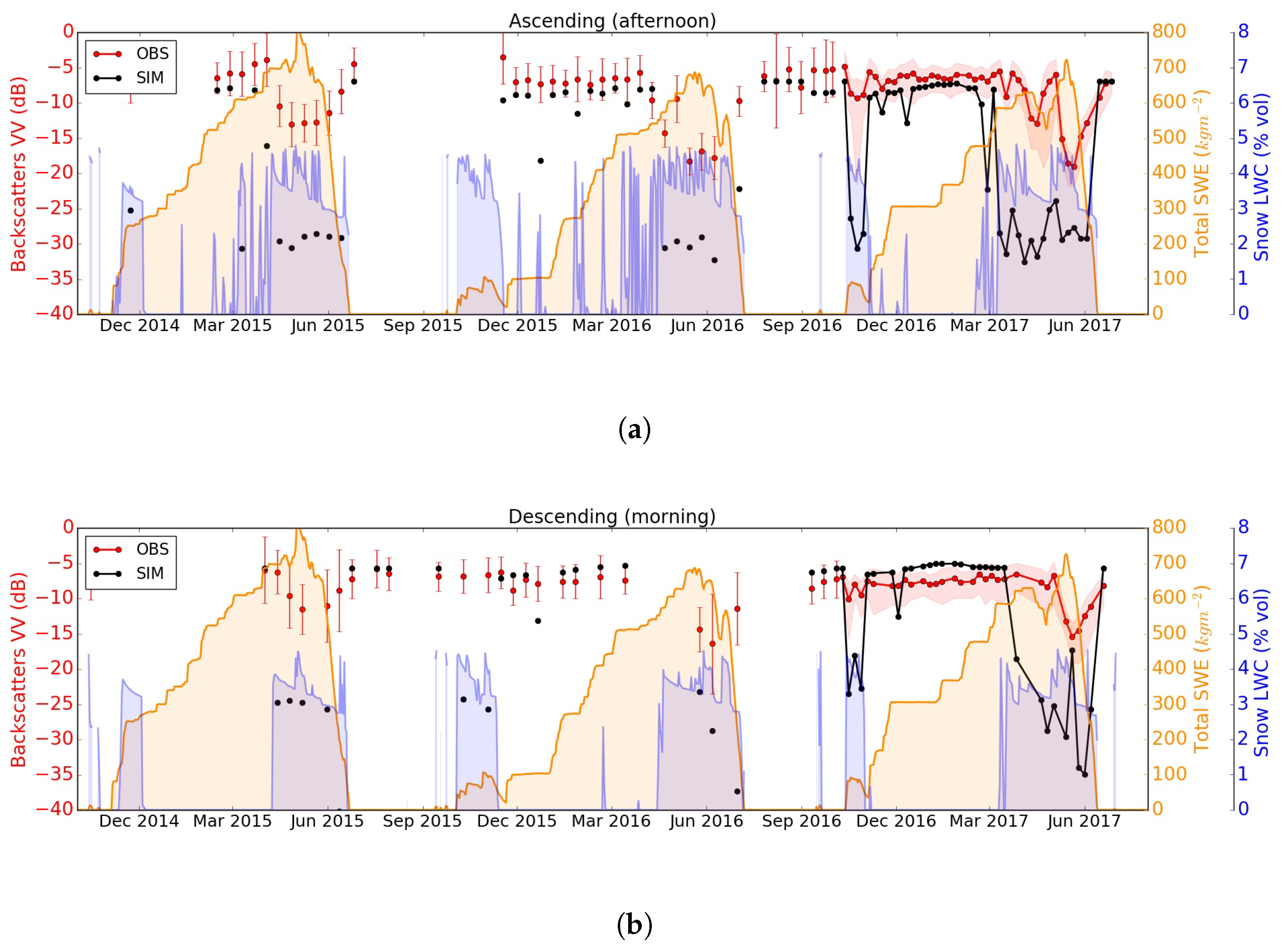
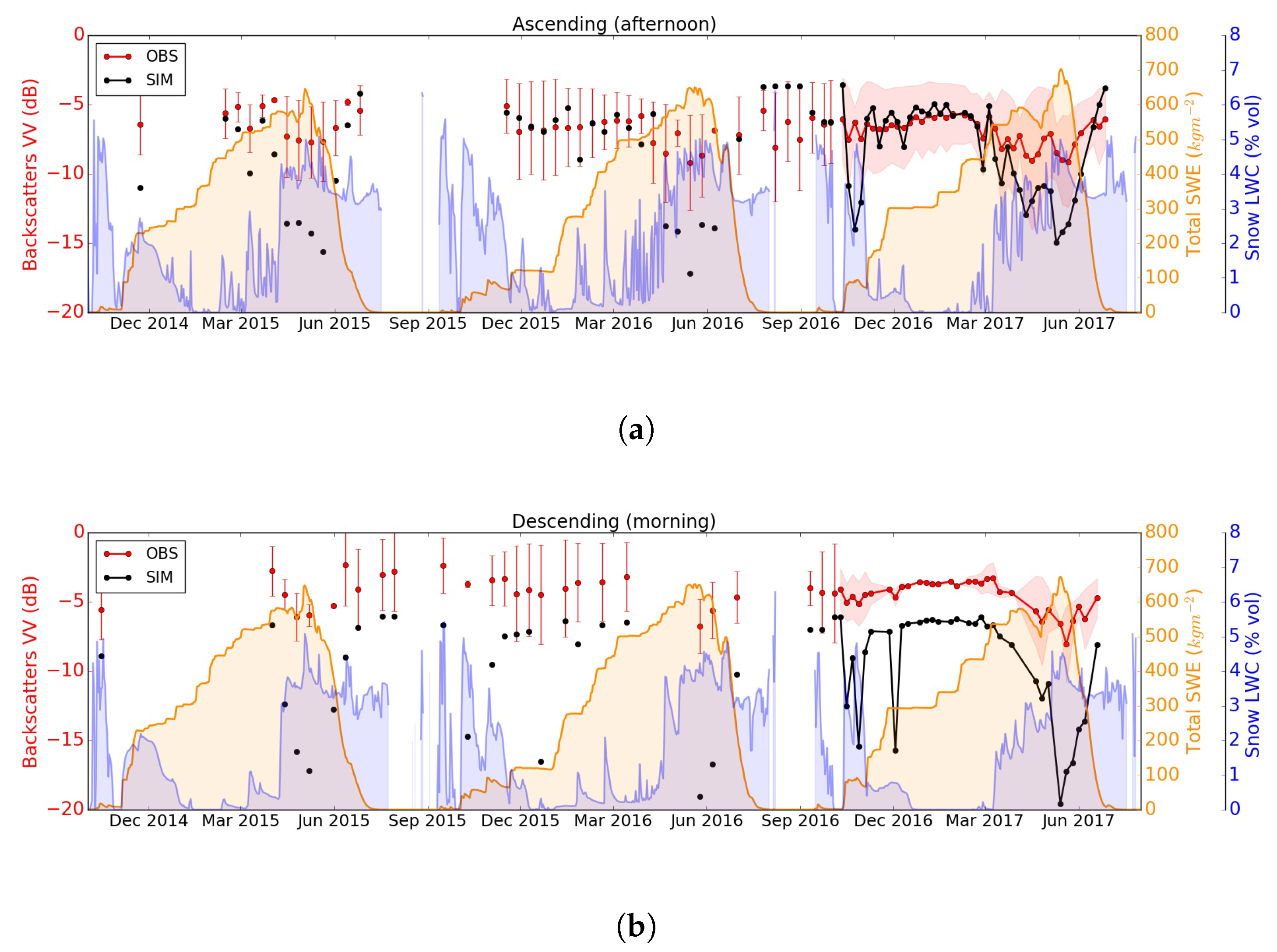
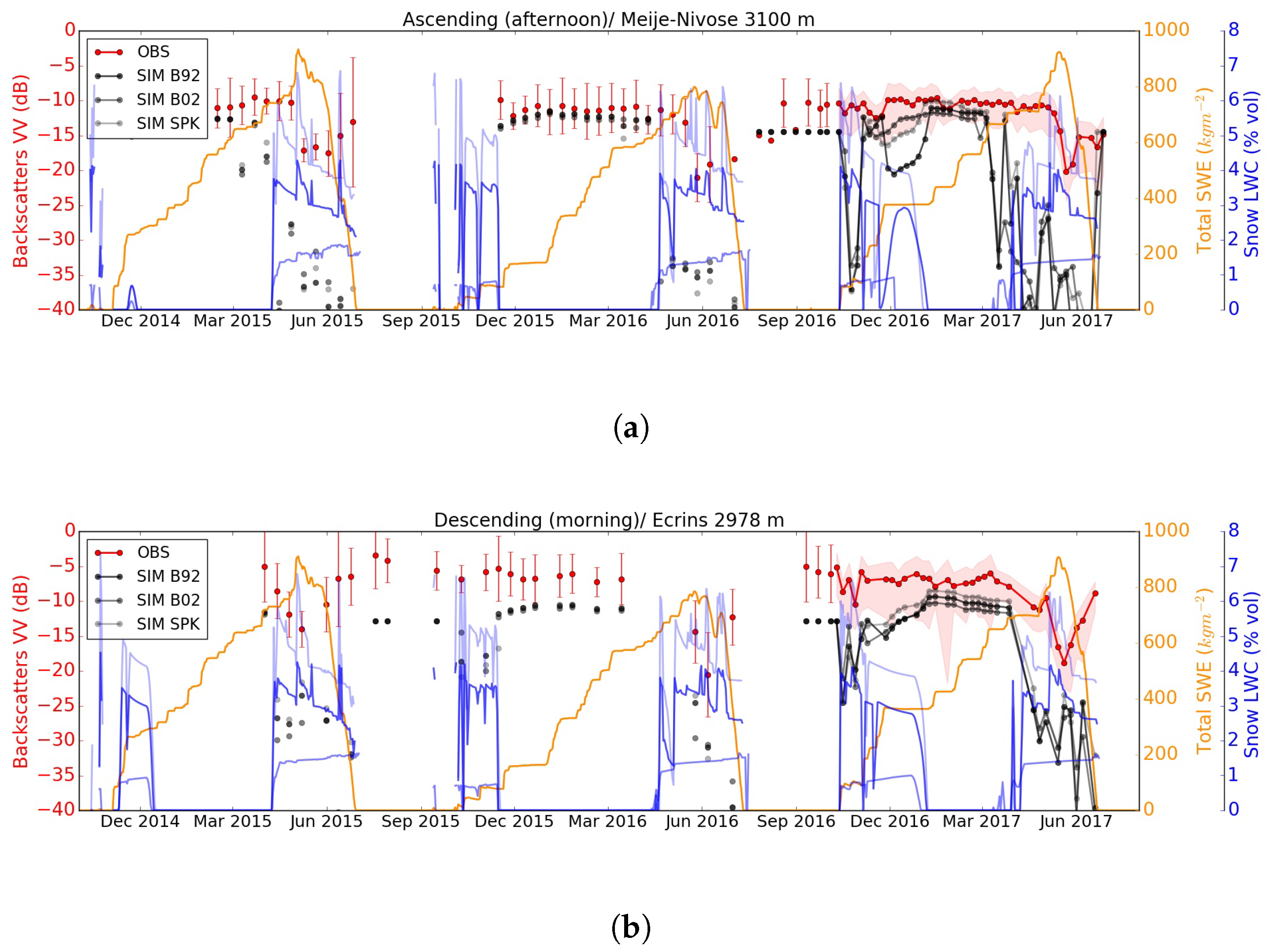
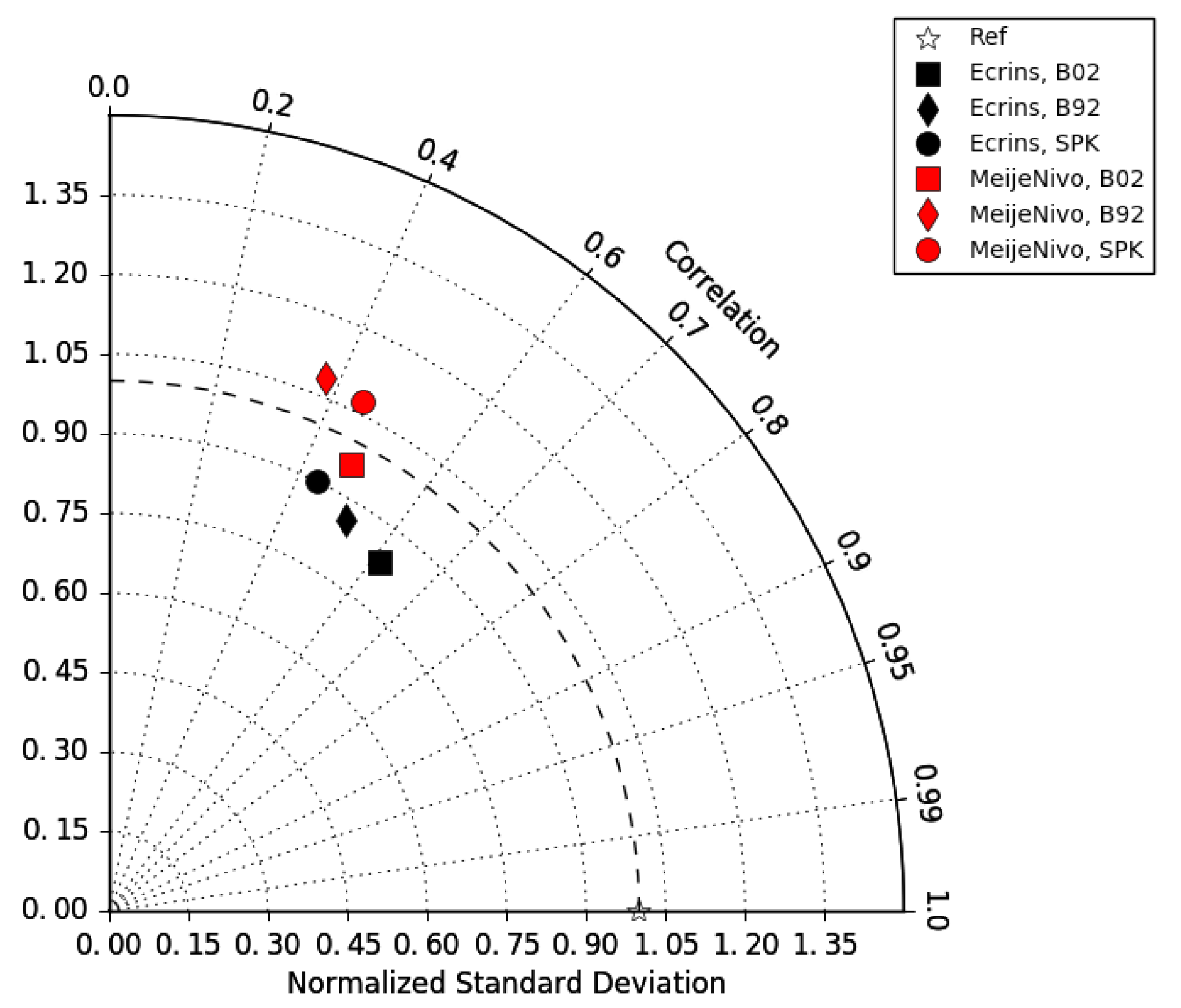
| Date | Satellite/Orbit Dir. | Date | Satellite/Orbit Dir. | Date | Satellite/Orbit Dir. |
|---|---|---|---|---|---|
| 03 October 2014 | S1A-Desc | 14 May 2016 | S1A-Asc | 14 January 2017 | S1B-Desc |
| 15 October 2014 | S1A-Desc | 25 May 2016 | S1A-Desc | 15 January 2017 | S1B-Asc |
| 21 November 2014 | S1A-Asc | 26 May 2016 | S1A-Asc | 21 January 2017 | S1A-Asc |
| 03 December 2014 | S1A-Asc | 06 June 2016 | S1A-Desc | 26 January 2017 | S1B-Desc |
| 13 February 2015 | S1A-Asc | 07 June 2016 | S1A-Asc | 27 January 2017 | S1B-Asc |
| 25 February 2015 | S1A-Asc | 30 June 2016 | S1A-Desc | 01 February 2017 | S1A-Desc |
| 09 March 2015 | S1A-Asc | 01 July 2016 | S1A-Asc | 08 February 2017 | S1B-Asc |
| 21 March 2015 | S1A-Asc | 13 July 2016 | S1A-Asc | 13 February 2017 | S1A-Desc |
| 01 April 2015 | S1A-Desc | 25 July 2016 | S1A-Asc | 14 February 2017 | S1A-Asc |
| 02 April 2015 | S1A-Asc | 06 August 2016 | S1A-Asc | 19 February 2017 | S1B-Desc |
| 13 April 2015 | S1A-Desc | 18 August 2016 | S1A-Asc | 20 February 2017 | S1B-Asc |
| 14 April 2015 | S1A-Asc | 30 August 2016 | S1A-Asc | 25 February 2017 | S1A-Desc |
| 25 April 2015 | S1A-Desc | 10 September 2016 | S1A-Desc | 26 February 2017 | S1A-Asc |
| 26 April 2015 | S1A-Asc | 11 September 2016 | S1A-Asc | 03 March 2017 | S1B-Desc |
| 07 May 2015 | S1A-Desc | 22 September 2016 | S1A-Desc | 04 March 2017 | S1B-Asc |
| 08 May 2015 | S1A-Asc | 23 September 2016 | S1A-Asc | 09 March 2017 | S1A-Desc |
| 20 May 2015 | S1A-Asc | 29 September 2016 | S1B-Asc | 10 March 2017 | S1A-Asc |
| 31 May 2015 | S1A-Desc | 04 October 2016 | S1A-Desc | 15 March 2017 | S1B-Desc |
| 01 June 2015 | S1A-Asc | 10 October 2016 | S1B-Desc | 16 March 2017 | S1B-Asc |
| 12 June 2015 | S1A-Desc | 11 October 2016 | S1B-Asc | 21 March 2017 | S1A-Desc |
| 13 June 2015 | S1A-Asc | 16 October 2016 | S1A-Desc | 22 March 2017 | S1A-Asc |
| 24 June 2015 | S1A-Desc | 17 October 2016 | S1A-Asc | 27 March 2017 | S1B-Desc |
| 25 June 2015 | S1A-Asc | 22 October 2016 | S1B-Desc | 28 March 2017 | S1B-Asc |
| 07 July 2015 | S1A-Asc | 23 October 2016 | S1B-Asc | 03 April 2017 | S1A-Asc |
| 18 July 2015 | S1A-Desc | 28 October 2016 | S1A-Desc | 09 April 2017 | S1B-Asc |
| 16 September 2015 | S1A-Desc | 29 October 2016 | S1A-Asc | 15 April 2017 | S1A-Asc |
| 10 October 2015 | S1A-Desc | 03 November 2016 | S1B-Desc | 20 April 2017 | S1B-Desc |
| 03 November 2015 | S1A-Desc | 04 November 2016 | S1B-Asc | 21 April 2017 | S1B-Asc |
| 15 November 2015 | S1A-Desc | 09 November 2016 | S1A-Desc | 26 April 2017 | S1A-Desc |
| 27 November 2015 | S1A-Desc | 10 November 2016 | S1A-Asc | 27 April 2017 | S1A-Asc |
| 09 December 2015 | S1A-Desc | 16 November 2016 | S1B-Asc | 02 May 2017 | S1B-Desc |
| 10 December 2015 | S1A-Asc | 21 November 2016 | S1A-Desc | 03 May 2017 | S1B-Asc |
| 21 December 2015 | S1A-Desc | 22 November 2016 | S1A-Asc | 09 May 2017 | S1A-Asc |
| 22 December 2015 | S1A-Asc | 27 November 2016 | S1B-Desc | 14 May 2017 | S1B-Desc |
| 03 January 2016 | S1A-Asc | 28 November 2016 | S1B-Asc | 15 May 2017 | S1B-Asc |
| 14 January 2016 | S1A-Desc | 03 December 2016 | S1A-Desc | 20 May 2017 | S1A-Desc |
| 15 January 2016 | S1A-Asc | 04 December 2016 | S1A-Asc | 21 May 2017 | S1A-Asc |
| 26 January 2016 | S1A-Desc | 09 December 2016 | S1B-Desc | 26 May 2017 | S1B-Desc |
| 27 January 2016 | S1A-Asc | 10 December 2016 | S1B-Asc | 27 May 2017 | S1B-Asc |
| 08 February 2016 | S1A-Asc | 15 December 2016 | S1A-Desc | 01 June 2017 | S1A-Desc |
| 19 February 2016 | S1A-Desc | 16 December 2016 | S1A-Asc | 02 June 2017 | S1A-Asc |
| 20 February 2016 | S1A-Asc | 22 December 2016 | S1B-Asc | 07 June 2017 | S1B-Desc |
| 03 March 2016 | S1A-Asc | 27 December 2016 | S1A-Desc | 14 June 2017 | S1A-Asc |
| 14 March 2016 | S1A-Desc | 28 December 2016 | S1A-Asc | 19 June 2017 | S1B-Desc |
| 27 March 2016 | S1A-Asc | 02 January 2017 | S1B-Desc | 20 June 2017 | S1B-Asc |
| 08 April 2016 | S1A-Asc | 03 January 2017 | S1B-Asc | 26 June 2017 | S1A-Asc |
| 20 April 2016 | S1A-Asc | 08 January 2017 | S1A-Desc | ||
| 02 May 2016 | S1A-Asc | 09 January 2017 | S1A-Asc |
| Elevation | Ascending Orbit (6 p.m.) | Descending Orbit (6 a.m.) | Number of Pixels | |||
|---|---|---|---|---|---|---|
| VV | VH | VV | VH | Ascending | Descending | |
| 1050–1350 m | 0.16 | 0.15 | 0.32 | −0.06 | 201,434 | 264,038 |
| 1350–1650 m | −0.02 | 0.26 | 0.08 | −0.009 | 555,769 | 660,583 |
| 1650–1950 m | −0.14 | 0.47 | −0.22 | 0.008 | 1,606,929 | 1,594,468 |
| 1950–2250 m | 0.22 | 0.76 | 0.10 | 0.14 | 3,043,131 | 2,862,822 |
| 2250–2550 m | 0.54 | 0.86 | 0.54 | 0.31 | 3,766,660 | 3,720,659 |
| 2550–2850 m | 0.68 | 0.82 | 0.76 | 0.34 | 2,947,326 | 2,911,437 |
| 2850–3150 m | 0.58 | 0.52 | 0.74 | 0.39 | 1,388,229 | 1,341,956 |
| >3150 m | 0.22 | 0.49 | 0.54 | 0.49 | 680,525 | 626,407 |
© 2018 by the authors. Licensee MDPI, Basel, Switzerland. This article is an open access article distributed under the terms and conditions of the Creative Commons Attribution (CC BY) license (http://creativecommons.org/licenses/by/4.0/).
Share and Cite
Veyssière, G.; Karbou, F.; Morin, S.; Lafaysse, M.; Vionnet, V. Evaluation of Sub-Kilometric Numerical Simulations of C-Band Radar Backscatter over the French Alps against Sentinel-1 Observations. Remote Sens. 2019, 11, 8. https://doi.org/10.3390/rs11010008
Veyssière G, Karbou F, Morin S, Lafaysse M, Vionnet V. Evaluation of Sub-Kilometric Numerical Simulations of C-Band Radar Backscatter over the French Alps against Sentinel-1 Observations. Remote Sensing. 2019; 11(1):8. https://doi.org/10.3390/rs11010008
Chicago/Turabian StyleVeyssière, Gaëlle, Fatima Karbou, Samuel Morin, Matthieu Lafaysse, and Vincent Vionnet. 2019. "Evaluation of Sub-Kilometric Numerical Simulations of C-Band Radar Backscatter over the French Alps against Sentinel-1 Observations" Remote Sensing 11, no. 1: 8. https://doi.org/10.3390/rs11010008
APA StyleVeyssière, G., Karbou, F., Morin, S., Lafaysse, M., & Vionnet, V. (2019). Evaluation of Sub-Kilometric Numerical Simulations of C-Band Radar Backscatter over the French Alps against Sentinel-1 Observations. Remote Sensing, 11(1), 8. https://doi.org/10.3390/rs11010008






